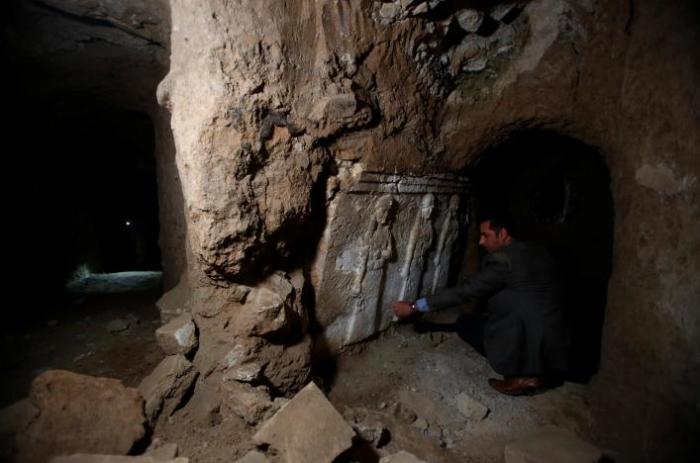ISIS' Destruction of Tomb of Jonah Reveals Ancient Inscription, Winged Bulls, Lions of Biblical King

The Islamic State terror group's destruction of the tomb of the prophet Jonah in the city of Nineveh has uncovered ancient inscriptions and "winged bulls and lions" belonging to the biblical King Esarhaddon, who ruled 2,700 years ago.
The Associated Press provided the latest update on the work of Iraqi archaeologists exploring the tunnels dug by IS after they destroyed Jonah's shrine in 2014, and revealed that more of Esarhaddon's palace has been uncovered.
"Ancient inscriptions and winged bulls and lions were found deep in the tunnels, thought to be part of the palace of King Esarhaddon, who ruled the Neo-Assyrian empire in the 7th century B.C.," AP reported on Sunday.
"The militants may have been looking for artifacts to loot. ISIS was pushed out of eastern Mosul by Iraqi forces in January. The battle continues for western Mosul."
The research team believes that IS militants dug tunnels beneath the shrine to get access to a number of ancient artifacts, such as statues, coins, jewelry and mosaics, in order to sell them on the black market and fund their war efforts.
Previously, the archaeologists followed one of the tunnels to a marble cuneiform inscription belonging to Esarhaddon, who ruled from 681 to 669 B.C., and renovated the palace built for King Sennacherib.
The Bible describes part of Sennacherib's military rule in II Chronicles 32:1, where it says: "After all that Hezekiah had so faithfully done, Sennacherib king of Assyria came and invaded Judah. He laid siege to the fortified cities, thinking to conquer them for himself."
"I can only imagine how much Daesh discovered down there before we got here," archaeologist Layla Salih said back then, using an alternative name for IS.
"We believe they took many of the artifacts, such as pottery and smaller pieces, away to sell. But what they left will be studied and will add a lot to our knowledge of the period."
Esarhaddon ruled ancient Assyria for 12 years in the early 7th century B.C., Reuters noted, and was Sennacherib's son.
"The whole palace remained untouched by the experts and foreign excavation," said archaeologist Musab Mohammed Jassim, from the Nineveh Antiquities and Heritage Department.
"So this site, the Esarhaddon Palace, maintained all its features ... It contains large collections of sculptures of different sizes and shapes and valuable artifacts."
As Science World pointed out, the Islamic radicals used dynamite to destroy the shrine built on the burial site of Jonah, as part of their ongoing efforts to erase Christianity from their captured territory.
Jonah is said to have preached to the people of Nineveh to turn to God and repent of their sins during the reign of Jeroboam in 780 B.C to 750 B.C.
The prophet is also described in the Bible as being swallowed by a whale, which is seen as a prototype of the death and resurrection of Jesus Christ, according to scholars Joel S. Baden and Candida Moss.
A senior official of the U.S.-led coalition in Iraq, meanwhile, said on Sunday that the remaining western Mosul neighborhoods held by IS have been surrounded, with the Iraqi army confident that the entire city will soon be liberated.
Brett McGurk, the special presidential envoy for the global coalition against ISIS, shared news of the developments during a press conference in Baghdad, AP noted.




























